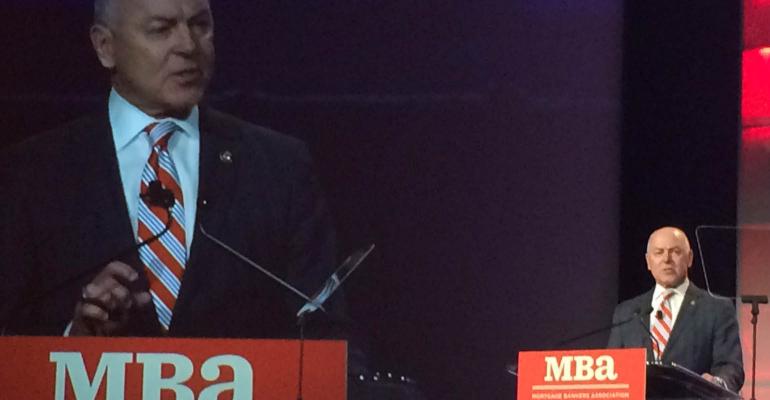As the annual MBA’s CREF/Multifamily convention got underway this week in San Diego, attendees expressed a healthy level of appetite for originating new loans and a desire to lend the same amount or more this year than they did in 2017. Last year, commercial and multifamily mortgage originations increased by 15 percent compared to 2016, according to preliminary estimates from the MBA’s quarterly survey of commercial/multifamily bankers. With a growing number of players in the debt space, that growth rate is likely to be matched in 2018. But greater competition might also come with some downsides. Here are the takeaways from day one of the show:
- The increasing number of debt funds in the marketplace is putting pressure on banks to offer higher leverage, lower pricing and no recourse to attract borrowers, according to Kathleen Farrell, head of commercial real estate for SunTrust Bank. “There’s a new fund every couple of weeks,” noted Chris Niederpruem, managing director of CIT Real Estate Finance. “Their prices in the past couple of weeks have really dropped.”
- However, most banks remain reluctant to offer terms matching those of alternative lenders. “A lot of us have long memories about difficult work-out situations,” Farrell said. Doug Faithfull, executive vice president and chief lending officer with Cambridge Savings Bank, echoed that sentiment. “In 2018, I’d like to lend more, but I actually expect to lend less because of the competition. We want to maintain our credit standards.”
- At the same time, debt funds are beginning to feel the heat from foreign players wanting to invest in U.S. real estate debt. “Foreign capital is a positive—they are investors in all of our funds,” said Jimmy Yung, managing director of Blackstone Real Estate Debt Strategies. “But it’s also challenging because they are starting to lend to our borrowers at lower yields compared to [our investors].”
- Bankers currently feel an “insatiable appetite” for loans underwriting industrial projects, according to Farrell. She noted that it took some time for SunTrust to get comfortable with speculative construction deals in the industrial space, but this is a sector where “it’s really a case where ‘if you build it, they will come.’” Luxury multifamily projects, on the other hand, are gradually falling out of favor with lenders because of potential over-supply issues in that space. In 2018, upscale multifamily “is a piece of the business we are not looking to grow necessarily. We tend to be cautious on multifamily,” noted Niederpruem.
- When it comes to the office sector, banks may not be as enamored of co-working concepts as other players in the marketplace. While the office sector may be evolving overall, there is concern companies like WeWork may or may not be around in the long term, said Farrell. “The future is still a little bit uncertain around the impact they are going to have in the office space.”
- Meanwhile, banks continue to have to guess which loans fall under the HVCRE regulations, as “there’s no consistency whatsoever how you define [it],” said Farrell. So if SunTrust executives feel the construction loan pencils out and the borrower is a someone they like to work with, they will go ahead with the deal. Cambridge Savings Bank, meanwhile, has stepped away from some attractive deals that may have had an “HVCRE component,” according to Faithfull.
- Most panelists at the show expect interest rates to rise this year, and some believe this will have a negative effect on the commercial real estate market. “We will see a negative effect on asset values,” as a result of rising rates, said Greta Guggenheim, CEO and president of TPG Finance Real Estate Trust. “We really stress the exit of the stabilized cash flow with higher interest rates.”
- Likewise, most speakers seemed to agree that the current real estate cycle is in its later stages, but no one expressed the belief that a downturn was imminent. “There’s no indicator right now that says a recession is coming right away,” according to Farrell.
- In a guess as to what is going to cause the next recession, Victor Calanog, chief economist and senior vice president with research firm Reis and Ryan McCullough, real estate economist with CoStar Portfolio Strategy, both pointed to the Fed potentially missing the mark on monetary policy. “The scary thing is that no one has a good idea of where the natural rate of interest is in the United States,” said Calanog. According to McCullough, historically, the two most common causes of recessions have been “the Fed over-tightening and energy crises.”
0 comments
Hide comments

